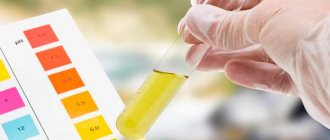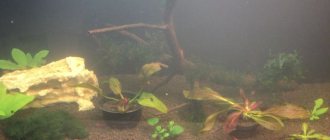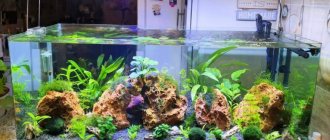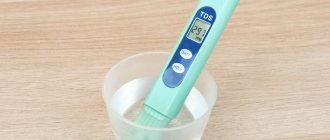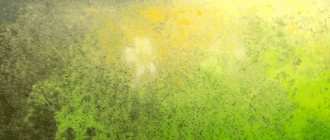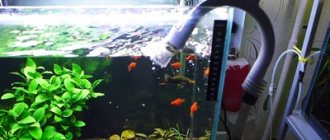What it is?
Acid-base state or pH is the ratio of acids and bases contained in water.
The parameter includes 2 types of main particles:
- carbonates are stable elements that increase rigidity and alkalize the environment;
- carbonic acid is an unstable indicator, prone to constant changes, increases the level of acidity.
The parameter has a scale of 14 units. If it is equal to 7, it means that the environment is neutral. The lower limits are called acidic, the upper limits are called alkaline.
Metabolic products of fish and plants lead to an increase in acidity . Therefore, pH gradually shifts downward.
Phosphates
Phosphorus compounds are important for underwater plants, as well as for maintaining biological balance. The higher the PO4 level, the higher the risk that the water will “bloom,” that is, the walls and decor in the aquarium will become covered with a coating of algae. The fish experience oxygen starvation, as well as the risk of poisoning from the waste products of cyanobacteria.
It is recommended for the herbalist to maintain nitrates and phosphates in a certain ratio in the aquarium. There are tables that determine this parameter depending on the type of plants in the water. This indicator can be increased easily: with special fertilizers.
How to reduce phosphates in a community aquarium
- Reduce population: the more fish, the higher the phosphorus level.
- Create conditions for good plant growth (fertilizers).
- PO4 concentrations can be reduced with water conditioners or phosphate neutralizers.
Factors that change the indicator of aquarium water
Water constantly changes its composition as it interacts with the environment and living organisms live in it. Therefore, acidity can periodically increase or decrease under the influence of certain factors.
Increasingly
An increase in pH is formed due to an increase in the amount of carbonates. This mechanism is called alkalization. This leads to an increase in density, which negatively affects the condition of the fish.
The factors described in the table lead to such actions:
| Factor | Description |
| Oxygen saturation | The more air oxygen penetrates into the aquatic environment, the lower the carbon dioxide concentration becomes. The condition occurs due to frequent use of the air supply mechanism (aerator). |
| Release of particles from decorative elements | Many people use rocks, corals, and castles placed on the bottom. Over time, objects release minerals. They increase the pH. |
| Direct sunlight | Photosynthesis is accelerated in algae leaves. A large amount of carbonates is released. |
The most active changes are observed when using a large amount of vegetation. This happens during the daytime under the influence of sunlight. Therefore, the environment is stabilized by reducing or completely eliminating algae.
Reductions
Ph is reduced by the following factors:
Carbon dioxide supply. The substance is used to enhance plant growth. Since it is unstable when interacting with water, decomposition occurs with the formation of carbon dioxide. Therefore, acidity increases and the pH value becomes lower.- Life activity of fish. Underwater inhabitants can also breathe, which increases acidity. Some of the substances they emit contain carbon dioxide.
- Decorative compositions (driftwood) release minerals over time. So the PH decreases.
- Temperature. If it is high, the water quickly acidifies.
- Nitrification. The reaction is formed due to bacteria living in the filter and soil. Ammonia oxidizes, releasing acid. The process occurs when the aquarium is rarely cleaned.
- Methane fermentation. Living organisms secrete biological substances. They undergo destruction releasing methane particles.
- Reducing water in an aquarium that has not been cleaned for a long time. The normal ratio of substances is disrupted. There are more acids and less water.
Reverse osmosis
Acidity does not decrease due to high carbonate hardness of water? Start by purifying your water through a reverse osmosis filter. This will ensure low mineral content. The second step is to add available means to the water to reduce the pH: driftwood, a decoction of alder cones, peat or peat chips (in the filter).
Is there no way to use natural materials? Then take the risk of turning to store-bought products. For example, to the Tetra or Sera line. These German companies specialize in the production of products and food for aquarium inhabitants. They have been on the market for a long time and have proven themselves on the positive side.
You lower the pH to the desired level, and then restore the hardness by adding the necessary mineral supplements to the aquarium.
Stable acidity level
For each fish species, the best indicator of environmental balance is determined. Small fluctuations are acceptable, in which vital activity is maintained.
Fresh
For freshwater species, a neutral value is better . However, it cannot be maintained for a long time. Therefore, fluctuations within 6-8 units are acceptable.
Nautical
Marine life does not survive in an acidic environment. It must be alkaline. The optimal pH value is 8-8.5 units.
Step-by-step instructions for measuring it
There are many ways to measure the pH of water. They use simple methods that anyone can do.
Test system
Components:
- a box of test strips, which indicates the immersion time, a color scale for identifying ph;
- test strips.
Progress of the study:
- The test strip is immersed in water for the specified time.
- Take it out of the water and compare it with the color scale.
If a person has doubts, he can repeat the study again. It is suitable for home use.
Drip indicator
Components:
- indicator in drops;
- shade scale.
Progress of the study:
- Calculate the amount of indicator required for the test (the parameters are indicated on the packaging).
- The required amount of solution is dripped.
- A comparative analysis of the resulting shade with the scale is carried out.
The identified indicators are not 100% accurate. They provide approximate values only.
Ph meter
The only equipment you will need is a ph meter.
Progress of the study:
- the tip is lowered into water (outwardly it is similar to a thermometer);
- it is kept in the aquarium until a characteristic sound appears, indicating the completion of the study.
This is a measuring device that determines precise acidity parameters. It will be needed by people who breed fish in large quantities. For example, for selling expensive animals.
Nitrates and nitrites
These parameters depend on the number of fish in the tank. The life of fish is impossible without the nitrogen cycle. It consists of three steps:
- Excretion of life waste by fish that contains ammonia. Leftover uneaten food also affects the concentration of this compound.
- The bacteria that make up the biosphere balance of the aquarium convert ammonia into nitrites (ammonium salts).
- Other bacteria, also an integral part of the biotope in glass walls, convert nitrites into nitrates (salts of nitric acid).
Both groups of bacteria are called by the same word - nitrifications. It is these that experienced aquarists strive to introduce into a new tank in order to prepare the water for the colonization of fish. This is done using water from an old aquarium, an old filter sponge or uncleaned decor.
Ammonia is a harmful compound that is harmful to fish and can cause poisoning. It is retained by the soil. Nitrites are also not harmless compounds that poison the water if their level is exceeded. Nitrates are considered the least harmful components of the nitrogen cycle, but if their levels are high, the question arises: how to lower nitrates in the aquarium. First, let’s figure out what level of each compound is acceptable.
- The normal nitrate level is 20-30 mg/l. If biological balance is maintained and other water parameters are observed, it remains so without additional actions on the part of the aquarist. True, there are fish for which this level is high; such representatives of the underwater world are considered sensitive and difficult to keep.
- Nitrite levels are acceptable within the range of 0.1 to 0.2 mg/l.
- Ammonia must immediately become a participant in the nitrogen cycle.
If the level of NO2 or NO3 in the water is higher than comfortable, the fish become lethargic, refuse food, do not reproduce, lose color, and do not grow. In the end, their immunity decreases: the fish die from any infection.
How to find out the level of nitrates and nitrites:
- Test strips with color indicator;
- Drip tests;
- Digital tests.
High levels of nitrogen compounds can be found not only in aquarium water, but also in tap water. Therefore, tests should be carried out regularly, including the water that is planned to be used for replacement.
In some cases it is necessary to increase the concentration of nitrogenous compounds. They are essential for the good growth of aquarium plants.
How to increase nitrate and nitrite levels
- Applying fertilizer or top dressing. Fertilizers contain potassium, phosphorus and nitrogen.
- Experienced aquarists make fertilizer for the aquarium with their own hands: potassium (potassium nitrate) is mixed with urea and ammonium nitrate in certain proportions.
- Herbalists need live fish - they create the basis for the nitrogen cycle.
How to reduce nitrates
- Water purification with a reverse osmosis filter.
- Using a special filler for the external filter.
- Adding special preparations to water to reduce the concentration of nitrogen compounds.
- Get aquarium plants. Unpretentious ones are suitable if there is no desire to care for capricious ones and create conditions for them to grow.
A good way to remove nitrates is to simply regularly (once a week or two) replace a quarter of the aquarium’s volume. Before changing the fresh water, it would be a good idea to add conditioner or special devices for water purification.
Downgrade Methods
An acidic environment is much more dangerous for fish than an alkaline one. Therefore, when the parameter decreases by more than 6 units, one of the following methods must be immediately carried out.
Sour peat method
Components:
- peat, 5g;
- purified water, 1l;
- measuring system.
Procedure progress:
- Mix water and solid component.
- Measure pH (should be too high).
- The solution is gradually poured inside.
- Each time after adding the solution, measurements are taken.
Freezing
Components and devices:
- container;
- water;
- freezer.
Carrying out the method:
- Water is poured into the container.
- Place in the freezer.
- The container is removed when the water is only half frozen.
- A hole is made in the ice and the water is completely drained.
- Melt the remainder, adding little by little to the aquarium.
The method is suitable for people who do not want to use chemicals to change pH.
Ways to enlarge
If the water has become excessively alkaline, the pH is over 8.5 units, it must be lowered. Do this with caution so as not to create strong acidity. 2 methods are considered the most acceptable.
Baking soda
Components:
- baking soda, 1 g;
- boiled water, 20 liters;
- any convenient test system (test strips, indicator liquid, ph meter).
Carrying out the method:
- First dilute the soda in water, stirring thoroughly so that the substance is completely dissolved.
- Add a little to the aquarium, periodically measuring the condition of the water with the selected test system.
Instead of soda, you can use calcium carbonate. But they change the ratio of matter and water. Add 25 liters to 1 teaspoon of powder.
Boiling
Components:
- heating container;
- tap water.
Method progress:
- Add water to the container and put it on the fire, covering it with a lid.
- Keep on fire for 60 minutes.
- Cool to room temperature.
- The upper part is removed (2/3 of the volume).
- The remainder is gradually poured into the aquarium, periodically measuring the pH.
This is the simplest method. The amount of boiled water added depends on the volume of the aquarium.
How to lower pH in an aquarium
Lowering the pH level in an aquarium is usually more difficult than raising it. There are different options:
- Peat moss substrate. Place it in the filter hopper (in your purse) or under a layer of soil. They replace it every six months to prevent it from rotting. Peat gradually lowers the pH level. It is necessary to ensure that the peat placed under the soil does not rot.
- Peat decoction. Boil the product in distillate for 30 minutes (5 g per 1 liter). The water will turn dark brown. The broth is filtered and poured into the aquarium in small batches, distributing it evenly throughout the tank.
- Peat extract. A preparation based on peat extract, which contains tannin, humic acids and hormones. The use of the extract has a beneficial effect on fish, improves plant growth, and acts as a natural antiseptic. It is advisable to use this method of reducing acidity with peat extract when the aquarium is populated with difficult-to-care, rare breeds of fish.
- Driftwood. Many types of wood can be used to lower the pH. Tannins play the role of oxidizing agents. The driftwood is washed and used as an interior element. This method is good for aquatic inhabitants because it reduces the acidity level slowly and imperceptibly.
- Black tea. The active elements of tea are tannins, amino acids and alkaloids. It is necessary to brew concentrated tea in a separate container. Add in portions, measuring pH.
On a note! You can quickly achieve a dramatic decrease in pH in the aquarium by increasing the concentration of carbon dioxide.
